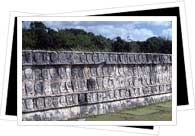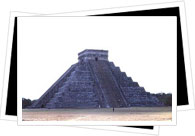
Playa del Carmen traces its roots to back to the pre-Columbian Mayan civilization. In fact, it was called “Xaman-Ha”, which in Mayan means “waters of the north.” Xaman-Ha was an important stop along the Mayan pilgrimage to Cozumel, considered a sacred island.
Xaman-Ha and the surrounding areas served not only as a religious center but also as a major trade route. This was during the post-Classical period (A.D. 1000 – 1500), about the time when the Mayan culture rose to its full height. During this time, the Mayan civilization flourished and produced great architectural and cultural splendors. However, at the end of the period, storms and wars served to drastically decrease the population and diminish the power and influence of the Mayan empire.
In 1518, a Spanish explorer named Juan de Grijalva came across Cozumel while on his way to Cuba. The following year, Hernan Cortez went to Cozumel on a mission to bring the Catholic belief to the Mayans. Sadly, he had Mayan temples demolished. To make matters worse, he brought a killer with him: smallpox. This disease cut a considerable swathe through the population. It was only after many years that the population was able to go back to its level during the height of Mayan rule.
The Spanish colonists traveled throughout the Yucatan and Playa del Carmen del Carmen area, bringing with them the Catholic faith. Some Europeans settled at Xel-Ha, which is just a few miles south of Playa del Carmen. This was the time when the area experienced a major boost in commerce.

As Spaniards continued with their colonization of the Yucatan area, there were Mayans and some Spanish refugees who resisted the occupation, resulting in the “War of the Castes.” This was when large groups from Valladolid settled into Cozumel and Tulum. Playa del Carmen kept a low profile at this time because of its remote location and dense forests.
The area was finally included as part of Mexican territory on 1902 and was named after General Andreas Quintana Roo. The U.S. navy used the island of Cozumel as their base during the second World War but it was only in the 1960s when it once again gained prominence. Jacques Cousteau, a documentary film producer and scuba adventurer, made a film showcasing the beauty of the island and the Great Mayan Reef, which is the second largest in the world.
In 1967, Mexico developed Cancun as a tourism destination (along with Los Cabos, Huatelco and Ixtapa). The mega-development project involved bridges, hotels and electric lines. A ferry service to Cozumel was established in Playa del Carmen and a wooden boat dock was put up in the central beach of Playa del Carmen. In 1974, the Cancun International Airport opened. Tourism also grew in Cozumel. At that time, Playa del Carmen was only thought to be the ferry dock on the way to Cozumel.
However, in the early 1980s, this quaint fishermen's village experienced a slow but sure development. Population in the city grew as people gradually recognized Playa del Carmen as a tourist spot in its own right. Its central spot in the Riviera Maya further strengthened this position.
Now, even with the challenges of hurricanes and the economy, tourism and development continue to flourish and Playa del Carmen stands as one of the favorite places to visit in Mexico.